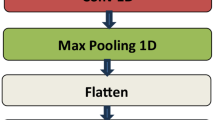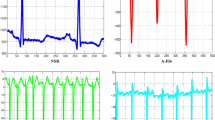Abstract
This paper proposes a quantum convolutional hybrid neural network (QCHNN) model for cardiac arrhythmia detection that integrates quantum computing (QC) into the convolutional neural network (CNN). By leveraging the automatic feature extraction capability of the CNN and the entanglement property of QC, the robustness against noise is improved. QCHNN ultimately realizes a robust and highly accurate detection model. First, the model converts the electrocardiography (ECG) signal into two-dimensional gray-scale images, thereby mitigating the effects of signal noise. We then use an annular parameterized quantum circuit (PQC) to form a fully connected quantum (FCQ) layer, which enhances robustness effectively. In this quantum layer, the PQC not only provides sufficient entanglement to complete the feature fusion task, but also can control the number of parameters. Finally, we perform experimental simulations to verify the high accuracy and robustness of the proposed model. The results show that the detection accuracy of QCHNN can be improved by about 15.94% in a small sample, and the best accuracy achieved for five types of arrhythmias is 98.58%. Moreover, we prove that the QCHNN model is more tolerant of noise than the CNN model by testing four types of noise.













Similar content being viewed by others
Explore related subjects
Discover the latest articles and news from researchers in related subjects, suggested using machine learning.Data availability
No datasets were generated or analyzed during the current study.
Abbreviations
- ECG:
-
Electrocardiogram
- QCHNN:
-
Quantum convolutional hybrid neural network
- QC:
-
Quantum computer
- QCs :
-
Quantum computers
- CNN :
-
Convolutional neural network
- ECG :
-
Electrocardiography
- PQC :
-
Parameterized quantum circuit
- FCQ :
-
Fully connected quantum
- ML :
-
Machine learning
- DL :
-
Deep learning
- QML :
-
Quantum machine learning
- NISQ :
-
Noisy intermediate-scale quantum
- NNs :
-
Neural networks
- FC :
-
Fully connected
References
Asgari S, Mehrnia A, Moussavi M (2015) Automatic detection of atrial fibrillation using stationary wavelet transform and support vector machine. Comput Biol Med 60:132–142
Azevedo V, Silva C, Dutra I (2022) Quantum transfer learning for breast cancer detection. Quantum Machine Intelligence 4(1):5
Beer K, Bondarenko D, Farrelly T, Osborne TJ, Salzmann R, Scheiermann D, Wolf R (2020) Training deep quantum neural networks. Nat Commun 11(1):808
Bergholm V, Izaac J, Schuld M, Gogolin C, Alam MS, Ahmed S, Arrazola J.M, Blank C, Delgado A, Jahangiri S (2018) Pennylane: Automatic differentiation of hybrid quantum-classical computations
Biamonte J, Wittek P, Pancotti N, Rebentrost P, Wiebe N, Lloyd S (2017) Quantum machine learning. Nature 549(7671):195–202
Bonavita I, Rafael-Palou X, Ceresa M, Piella G, Ribas V, Ballester MAG (2020) Integration of convolutional neural networks for pulmonary nodule malignancy assessment in a lung cancer classification pipeline. Comput Methods Programs Biomed 185:105172
Ceylan R, Özbay Y (2007) Comparison of fcm, pca and wt techniques for classification ecg arrhythmias using artificial neural network. Expert Syst Appl 33(2):286–295
Chakrabarti S, Yiming H, Li T, Feizi S, Wu X (2019) Quantum wasserstein generative adversarial networks. Advances in neural information processing systems 32
Cong I, Choi S, Lukin MD (2019) Quantum convolutional neural networks. Nat Phys 15(12):1273–1278
Dhal P, Azad C (2021) A multi-objective feature selection method using newton’s law based pso with gwo. Appl Soft Comput 107(6):107394
Dhal P, Azad C (2022) A lightweight filter based feature selection approach for multi-label text classification. J Ambient Intell Humaniz Comput 14(9):12345–12357
Dhal P, Azad C (2024) Hybrid momentum accelerated bat algorithm with gwo based optimization approach for spam classification. Multimed Tool Appl 83(9):26929–26969
Dhal P, Azad C (2024) A fine-tuning deep learning with multi-objective-based feature selection approach for the classification of text. Neural Comput Appl 36(7):3525–3553
Esteva A, Kuprel B, Novoa RA, Ko J, Swetter SM, Blau HM, Thrun S (2017) Dermatologist-level classification of skin cancer with deep neural networks. Nature 542(7639):115–118
Grzesiak N, Blümel R, Wright K, Beck KM, Pisenti NC, Li M, Chaplin V, Amini JM, Debnath S, Chen J-S et al (2020) Efficient arbitrary simultaneously entangling gates on a trapped-ion quantum computer. Nat Commun 11(1):2963
Güler I, Übeylı ED (2005) Ecg beat classifier designed by combined neural network model. Pattern Recogn 38(2):199–208
Hammad M, Abd El-Latif AA, Hussain A, Abd El-Samie FE, Gupta BB, Ugail H, Sedik A (2022) Deep learning models for arrhythmia detection in iot healthcare applications. Comput Electr Eng 100:108011
Henderson M, Shakya S, Pradhan S, Cook T (2020) Quanvolutional neural networks: powering image recognition with quantum circuits. Quantum Mach Intell 2(1):2
Hubregtsen T, Pichlmeier J, Stecher P, Bertels K (2020) Evaluation of parameterized quantum circuits: on the relation between classification accuracy, expressibility and entangling capability
Hur T, Kim L, Park DK (2022) Quantum convolutional neural network for classical data classification. Quantum Mach Intell 4(1):3
Inan OT, Giovangrandi L, Kovacs GT (2006) Robust neural-network-based classification of premature ventricular contractions using wavelet transform and timing interval features. IEEE Trans Biomed Eng 53(12):2507–2515
Isin A, Ozdalili S (2017) Cardiac arrhythmia detection using deep learning. Proced Comput Sci 120:268–275
Jordan MI, Mitchell TM (2015) Machine learning: Trends, perspectives, and prospects. Science 349(6245):255–260
Jun TJ, Nguyen HM, Kang D, Kim D, Kim D, Kim Y-H (2018) Ecg arrhythmia classification using a 2-d convolutional neural network. arXiv:1804.06812
Killoran N, Bromley TR, Arrazola JM, Schuld M, Quesada N, Lloyd S (2019) Continuous-variable quantum neural networks. Phys Rev Res 1(3):033063
Kiranyaz S, Ince T, Gabbouj M (2015) Real-time patient-specific ecg classification by 1-d convolutional neural networks. IEEE Trans Biomed Eng 63(3):664–675
Konar D, Sarma AD, Bhandary S, Bhattacharyya S, Cangi A, Aggarwal V (2023) A shallow hybrid classical-quantum spiking feedforward neural network for noise-robust image classification. Appl Soft Comput 136:110099
Konar D, Gelenbe E, Bhandary S, Sarma A.D, Cangi A (2022) Random quantum neural networks (rqnn) for noisy image recognition. arXiv:2203.01764
Ladavich S, Ghoraani B (2015) Rate-independent detection of atrial fibrillation by statistical modeling of atrial activity. Biomed Signal Process Control 18:274–281
LeCun Y, Bengio Y, Hinton G (2015) Deep learning. Nature 521(7553):436–444
LeCun Y et al (2015) Lenet-5, convolutional neural networks. http://yann.lecun.com/exdb/lenet 20(5):14
Linh TH, Osowski S, Stodolski M (2003) On-line heart beat recognition using hermite polynomials and neuro-fuzzy network. IEEE Trans Instrum Meas 52(4):1224–1231
Mathews SM, Kambhamettu C, Barner KE (2018) A novel application of deep learning for single-lead ecg classification. Comput Biol Med 99:53–62
Mathur N, Landman J, Li Y.Y, Strahm M, Kazdaghli S, Prakash A, Kerenidis I (2021) Medical image classification via quantum neural networks. arXiv:2109.01831
Moody GB, Mark RG (2001) The impact of the mit-bih arrhythmia database. IEEE Eng Med Biol Mag 20(3):45–50
Nayak A, Baidya Kayal E, Arya M, Culli J, Krishan S, Agarwal S, Mehndiratta A (2019) Computer-aided diagnosis of cirrhosis and hepatocellular carcinoma using multi-phase abdomen ct. Int J Comput Assist Radiol Surg 14:1341–1352
Nielsen MA, Chuang I (2002) Quantum computation and quantum information. American Association of Physics Teachers
Oh SL, Ng EY, San Tan R, Acharya UR (2018) Automated diagnosis of arrhythmia using combination of cnn and lstm techniques with variable length heart beats. Comput Biol Med 102:278–287
Papernot N, McDaniel P (2018) Deep k-nearest neighbors: Towards confident, interpretable and robust deep learning. arXiv:1803.04765
Paszke A, Gross S, Massa F, Lerer A, Chintala S (2019) Pytorch: An imperative style, high-performance deep learning library
Rai HM, Trivedi A, Shukla S (2013) Ecg signal processing for abnormalities detection using multi-resolution wavelet transform and artificial neural network classifier. Measurement 46(9):3238–3246
Rajpurkar P, Hannun A.Y, Haghpanahi M, Bourn C, Ng AY (2017) Cardiologist-level arrhythmia detection with convolutional neural networks. arXiv:1707.01836
Ramachandran P, Zoph B, Le QV (2017) Swish: a self-gated activation function. arXiv:1710.05941 7(1):5
Sahoo S, Kanungo B, Behera S, Sabut S (2017) Multiresolution wavelet transform based feature extraction and ecg classification to detect cardiac abnormalities. Measurement 108:55–66
Sahoo S, Dash M, Behera S, Sabut S (2020) Machine learning approach to detect cardiac arrhythmias in ecg signals: A survey. Irbm 41(4):185–194
Sannino G, De Pietro G (2018) A deep learning approach for ecg-based heartbeat classification for arrhythmia detection. Futur Gener Comput Syst 86:446–455
Schuld M, Sinayskiy I, Petruccione F (2015) An introduction to quantum machine learning. Contemp Phys 56(2):172–185
Sebastianelli A, Zaidenberg DA, Spiller D, Le Saux B, Ullo SL (2021) On circuit-based hybrid quantum neural networks for remote sensing imagery classification. IEEE Journal of selected topics in applied earth observations and remote sensing 15:565–580
Shadmand S, Mashoufi B (2016) A new personalized ecg signal classification algorithm using block-based neural network and particle swarm optimization. Biomed Signal Process Control 25:12–23
Shore J, Johnson R (1981) Properties of cross-entropy minimization. IEEE Trans Inf Theory 27(4):472–482
Sim S, Johnson PD, Aspuru-Guzik A (2019) Expressibility and entangling capability of parameterized quantum circuits for hybrid quantum-classical algorithms. Adv Quantum Technol 2(12):1900070
Slimane Z-EH, Naït-Ali A (2010) Qrs complex detection using empirical mode decomposition. Digital signal processing 20(4):1221–1228
Wójcik B, Morawiecki P, Śmieja M, Krzyżek T, Spurek P, Tabor J (2021) Adversarial examples detection and analysis with layer-wise autoencoders. In: 2021 IEEE 33rd International conference on tools with artificial intelligence (ICTAI), IEEE, pp 1322–1326
Zhao C, Gao X-S (2021) QDNN: Deep neural networks with quantum layers. Quantum Mach Intell 3(1):15
Funding
This work was supported in part by the National Natural Science Foundation of China (Grant no. 62103070), in part by the Science and Technology Research Program of Chongqing Municipal Education Commission (Grant no. KJZD-K202301103), and in part by the Chongqing Natural Science Foundation (Grant no. CSTB2023NSCQ-MSX0539).
Author information
Authors and Affiliations
Contributions
Shiyue Zhang, Aijuan Wang, and Lusi Li wrote the main manuscript text, and Shiyue Zhang prepared all figures. All authors reviewed the manuscript. These authors contributed equally to this work.
Corresponding author
Ethics declarations
Conflict of interest
The authors declare no competing interests.
Additional information
Publisher's Note
Springer Nature remains neutral with regard to jurisdictional claims in published maps and institutional affiliations.
Rights and permissions
Springer Nature or its licensor (e.g. a society or other partner) holds exclusive rights to this article under a publishing agreement with the author(s) or other rightsholder(s); author self-archiving of the accepted manuscript version of this article is solely governed by the terms of such publishing agreement and applicable law.
About this article
Cite this article
Zhang, S., Wang, A. & Li, L. Quantum-convolution-based hybrid neural network model for arrhythmia detection. Quantum Mach. Intell. 6, 75 (2024). https://doi.org/10.1007/s42484-024-00207-7
Received:
Accepted:
Published:
DOI: https://doi.org/10.1007/s42484-024-00207-7




